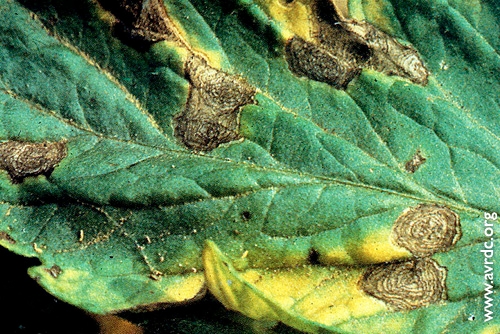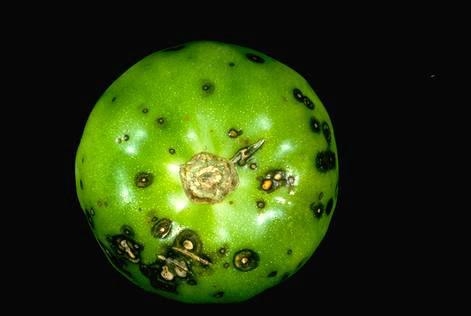Jun 10, 2015
Request from Client at Master Gardener's "Ask a Master Gardener" Help Desk  I bought this tomato from your Great Tomato Plant Sale in April. It's now late May and while the tomato is alive it sure is not looking good. It looks like it's diseased with spots on the leaves and "sores" on the main stem. It's.not looking good and I don't think it's going to survive or produce tomatoes. What should I do? (Note: Due to time constraints, the tomato specimen was subsequently transported to the MGCC office for further diagnosis and the promise to get back to the client via email.)
I bought this tomato from your Great Tomato Plant Sale in April. It's now late May and while the tomato is alive it sure is not looking good. It looks like it's diseased with spots on the leaves and "sores" on the main stem. It's.not looking good and I don't think it's going to survive or produce tomatoes. What should I do? (Note: Due to time constraints, the tomato specimen was subsequently transported to the MGCC office for further diagnosis and the promise to get back to the client via email.)
Response from MGCC's Help Desk: After further examining the tomato specimen that you brought to Our Garden' AAMG Help Desk yesterday in our Pleasant Hill Help Desk office, we believe that the plant may have been attacked by Early Blight. Early blight (Alternaria solani) is a fungal disease. The early symptom of the disease are round leaf spots that first appear on the older leaves. Stem lesions also develop on the stem at the base of the plant. We could observe both the leaf spotting and the stem lesions on your specimen. Had the plant been mature enough to have set fruit, you may also have observed spotting on the tomatoes.
Desk office, we believe that the plant may have been attacked by Early Blight. Early blight (Alternaria solani) is a fungal disease. The early symptom of the disease are round leaf spots that first appear on the older leaves. Stem lesions also develop on the stem at the base of the plant. We could observe both the leaf spotting and the stem lesions on your specimen. Had the plant been mature enough to have set fruit, you may also have observed spotting on the tomatoes.

tomato leaf w/early blight
Response from MGCC's Help Desk: After further examining the tomato specimen that you brought to Our Garden' AAMG Help Desk yesterday in our Pleasant Hill Help

tomato stem w/early blight
A common source of the fungal spores that cause early blight is debris from infected plants left in or on the soil (where it can survive at least 1 year), and spores from other affected plants dispersed by wind, water, insects, or animals. As explained in this University of California website, http://www.ipm.ucdavis.edu/PMG/GARDEN/VEGES/DISEASES/tomearlyblight.html the fungal spores require moisture for germination and infection. We also observed that the compost in which your tomato was planted was very wet. The wet planting medium, coupled with the cool and often cloudy weather we have experienced for the last few weeks, probably combined to create an environment favoring the development of the disease.

tomato w/early blight
Since the spores can survive in soil for at least a year, you will want to be sure that you do not attempt to grow any other tomatoes or other plants in the same plant family (Solanaceae, or nightshade family) including peppers, eggplants, potatoes, and tomatillos in the soil from the container in which you were growing the diseased tomato. All of the plants in this plant family can suffer from early blight. Also be sure to clean the container thoroughly before using it for another plant. After washing the container well, you can use a solution of 10% bleach and 90% water to rinse the container to increase your chances of killing all the pathogen spores.
In examining the tomato, we also noted that the root zone of the plant was very poorly developed. I understand that you purchased the tomato at our tomato plant sale in early April and had potted it in a container that was about a five gallon size. We would have expected the root system to have grown much larger by now. The compost in which the tomato was growing was very heavy and dense. You may have better luck with your tomatoes if you alter the potting soil medium you use. I also use compost in the containers in which I grow tomatoes, but before using it I mix the compost with equal amounts of perlite or vermiculite as well as some coconut coir. The perlite or vermiculite helps keep the mixture much lighter and creates better conditions for the roots to get the oxygen that the plant requires. The coconut coir increases the moisture holding capacity of the soil without allowing the soil mixture to become overly saturated with water.
Also, you may want to reduce the amount of water you give the tomatoes. When I examined the tomato this morning, the soil was so wet it was soggy and a significant amount of water had collected in the plastic bag in which the tomato was stored. I wouldn't expect to find such wet soil in a container in which a tomato was being grown except perhaps for an hour or so immediately after the plant had been well watered. After that time, the soil should dry out much more. Soggy soil prevents the roots from getting the oxygen the plant needs.
You might want to use the “squeeze method” to test the moisture level in the soils in your containers before giving your plants more water. Squeeze a handful of soil from the container firmly to do the test. If you squeeze the soil and it releases free moisture, you definitely do not need more water. In fact, you should not observe such conditions except immediately after you have watered or after a heavy rain. If you squeeze the soil and it readily forms and maintains a ball but does not release free moisture, the plant still has sufficient water and you can wait before adding more. If the soil won't form a ball or if it forms a ball only with much pressure and the ball falls apart readily, it's time to water again.
Finally, if you want to reduce the chances of having a recurrence of early blight next year, you might want to look for a variety that has better resistance to blight. I've listed below some tomato varieties (both heirlooms and hybrids) with some resistance to blight. Keep in mind, however, that even resistant varieties can suffer from blight if conditions are favorable for its development.
Hybrid, indeterminate, 60 days, red, elongated cherry (1 ounce), resistance: cracking, blight
Legend Tomato
OP (open-pollinated), determinate, 68 days, red, beefsteak (14-16 ounces), resistance: early blight, late blight (We had this variety at our tomato sale this year.)
Manalucie Tomato
Hybrid, indeterminate, 82 days, red, globe, resistance: blossom end rot, gray leaf mold, early blight, fusarium wilt
Matt's Wild Cherry Tomato
Heirloom, indeterminate, 70 days, red, cherry (1/2 inch), resistance: early blight
Mountain Fresh Plus Tomato
Hybrid, determinate, 77 days, red, globe (12 ounces), disease resistance: VFFN, blossom end rot, early blight
Mountain Supreme
Hybrid, determinate, 69-70 days, red, globe, resistance: VF, blight
Old Brooks Tomato
Heirloom, indeterminate, 78 days, red, globe (6-8 ounces), resistance: blossom end rot, early blight, late blight
Tommy Toe Tomato
Heirloom, indeterminate, 70 days, red, cherry (1 inch)
Legend Tomato
OP (open-pollinated), determinate, 68 days, red, beefsteak (14-16 ounces), resistance: early blight, late blight (We had this variety at our tomato sale this year.)
Manalucie Tomato
Hybrid, indeterminate, 82 days, red, globe, resistance: blossom end rot, gray leaf mold, early blight, fusarium wilt
Matt's Wild Cherry Tomato
Heirloom, indeterminate, 70 days, red, cherry (1/2 inch), resistance: early blight
Mountain Fresh Plus Tomato
Hybrid, determinate, 77 days, red, globe (12 ounces), disease resistance: VFFN, blossom end rot, early blight
Mountain Supreme
Hybrid, determinate, 69-70 days, red, globe, resistance: VF, blight
Old Brooks Tomato
Heirloom, indeterminate, 78 days, red, globe (6-8 ounces), resistance: blossom end rot, early blight, late blight
Tommy Toe Tomato
Heirloom, indeterminate, 70 days, red, cherry (1 inch)
Hope this information is helpful. You are welcome to contact us at our Help Desk or at Our Garden if you have additional questions.
Master Gardeners of Contra Costa Help Desk
Note: The Contra Costa Master Gardener Help Desk is available year-round to answer your gardening questions. Except for a few holidays, we're open every week, Monday through Thursday for walk-ins from 9:00 am to Noon at 75 Santa Barbara Road, 2d Floor, Pleasant Hill, CA 94523. We can also be reached via telephone: (925) 646-6586, email: ccmg@ucanr.edu, or on the web at http://ccmg.ucanr.edu/Ask_Us/